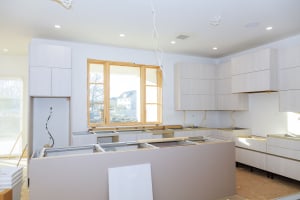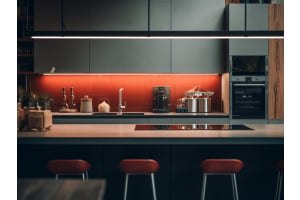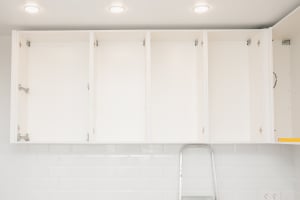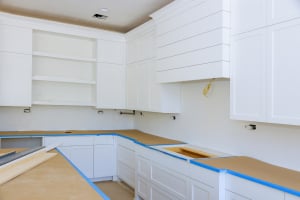Painting kitchen cabinets is a fantastic way to give a kitchen a new lease on life without emptying your checking account. The key to an outstanding look is to plan ahead, choose the correct materials, and use the highest-quality paint. The durability of high-quality painted cabinet doors can outlast the home itself if well-maintained.
Gather the Supplies
Before heading to the store, it is a good idea to remove the cabinet doors and examine the doors and frame. Look for damage such as warping, laminate peeling, holes, cracks, and stains. Carefully look at the cabinets and see if they are real wood, laminate, MDF, or metal. Depending on the material they are constructed of, they’ll need different supplies, paint, and preparation.
The following standard supplies will suffice regardless of cabinet type:
- Painters’ tape
- Paintbrushes (both medium and smaller)
- Plastic sheeting or drop cloths to keep everything clean
- Screwdriver or electric screw gun for removing the cabinets from their hinges
- Clean rags or sponges
There are also tools that are helpful depending on the cabinet type.
Laminate
- Medium grit sandpaper for sanding lightly before priming
- Bonding primer to ensure the paint adheres well to the laminate
- Latex paint to help achieve a durable finish
MDF
- Fine-grit sandpaper, because MDF is more fragile and would be damaged by medium grit paper
- Oil-based primer, because water-based primer causes the MDF to swell
- Acrylic or enamel paint, because latex paint can cause swelling
Real Wood
- High-grit and medium-grit sandpaper to help remove old paint
- Oil-based primer and paint to increase durability and prevent stains by locking out moisture
Metal
- Fine-grit sandpaper for removing any rust and smoothing the surface
- Rust-resistant primer to keep cabinets from deteriorating in the humid environment of a kitchen
- Oil-based enamel paint, which is exceptionally durable and perfect for metal
Lastly, the finish of the paint is a personal preference, though most kitchens use high or semi-gloss as it helps resist stains and cleans easier than matte paints.
Prep and Painting
Start by removing the cabinet doors by unscrewing them from the hinges. Leaving the hinges attached to the cabinet frame is recommended. Every hinge and its recessed area on the door and cabinet frame may fit differently. Removing the hinges from the frame entirely may lead to alignment problems if the hinges aren’t marked specifically for each door.
Tape off the areas at the edges where the cabinet frames and crowns touch walls, ceilings, or other surfaces; this will help to ensure clean lines and minimal clean-up. Also tape over the hinges unless painting over them is desired. Next, lay down the cabinet doors on the plastic sheeting and place sheeting or drop cloths anywhere else that isn’t being painted.
For removing old paint, it is important to not use chemical paint strippers on laminate or if you’re looking to repaint MDF cabinets. They can damage the material, wreak havoc through swelling, or even detach the laminate. Gently use sandpaper to remove paint. For larger jobs, it may be better to simply sand and primer over the old paint rather than remove it.
Cleaning the cabinets and frames carefully and completely is an extremely important step. Any areas not clean can quickly peel, crack, or form unsightly bumps and lines where food stains are painted over and remain forever. Be especially meticulous around the base of the frame and doors, as this is where food stains are most likely to occur.
Once the cabinets are clean, lightly sand the surface to prepare it for the primer. Apply the primer in even coats with long strokes. Be sure and keep the doors flat to prevent primer and paint drops from forming undesired streaks. For the frame itself, carefully apply the primer in an even coating.
After the primer has dried, lightly sand it and wipe it clean with a dry cloth. This will help the paint stick to the primer better. With the primer sanded, start the painting process.
Use a medium brush for the larger sections and a small brush for finely detailed sections that have designs or grooves. Always apply the minimum amount of paint and go over it again if it doesn’t fully cover the old finish. Once everything is complete, let it dry based on the manufacturer's recommendations and carefully reassemble the cabinetry.
Colored Cabinets Without the Mess
For those who want the highest quality colorful cabinets, look no further than 27estore. We offer a wide range of durable cabinetry in a range of colors–everything from durable high-pressure laminate to real wood veneer to metal is an option. Stop by our site today and find out how 27estore can give any kitchen an easy makeover!
Upgrade your kitchen with the understated elegance of blue and gray kitchen cabinets.













